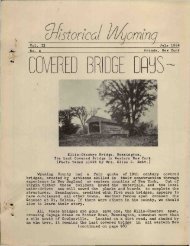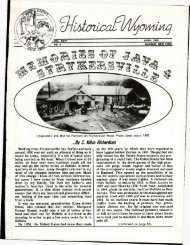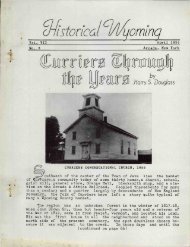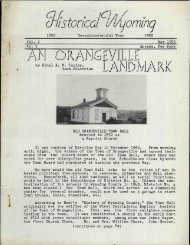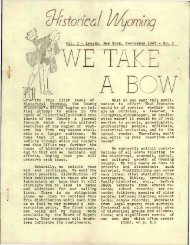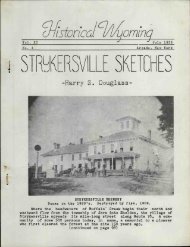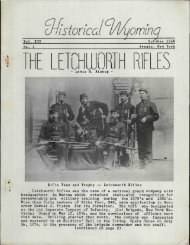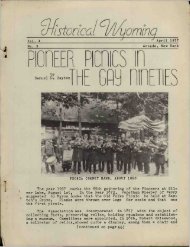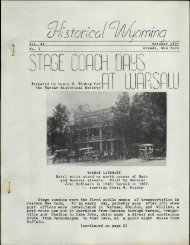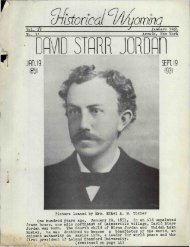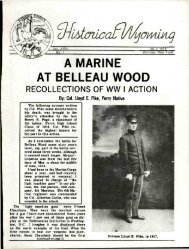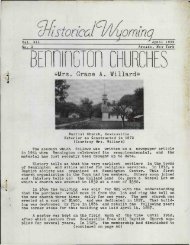Historical Wyoming County Jan 1980 - Old Fulton History
Historical Wyoming County Jan 1980 - Old Fulton History
Historical Wyoming County Jan 1980 - Old Fulton History
Create successful ePaper yourself
Turn your PDF publications into a flip-book with our unique Google optimized e-Paper software.
PAGE 72 JANUARY <strong>1980</strong><br />
(Village In The Valley Cont.)<br />
was the home of the merchant W.H. Ainsworth<br />
and his heirs sold the home in 1900 to J.M.<br />
Bryson. On the vacant lot next to this once<br />
stately home, once stood the house of Dr.<br />
Samuel Kennedy. On the knoll where the new<br />
home of the Hogle family was built was the<br />
site of the Thomas Bryson homestead when<br />
his family settled in the village.<br />
The present home of George Laird occupies<br />
the site of the first log school. The house was<br />
built during the late 1850's by William Service<br />
for Dr. J.W. Watson but the doctor never<br />
lived in this home. It became known as the<br />
Kittle place throughout the years for various<br />
members of this family occupied the residence.<br />
The site upon which the late Millard F. Embt<br />
built his new home was the original site of the<br />
structure that housed the Yellow Dog Saloon.<br />
At the time it was moved it was known as the<br />
Wilcox place. In earlier history it was the home<br />
of James H. Potter who operated a tannery<br />
near the site during the 1840's and 1850's.<br />
During the exacavating of Mr. Embt's home a<br />
pipe which supplied the water to the tannery<br />
was unearthed. The house presently occupied<br />
by Miss Norma Donnelly and her brother Louis<br />
was built in 1883 for Avery Thomas who was<br />
the village undertaker. His hearse building<br />
stood to the southeast of his home. Only two<br />
families have occupied this home,the Thomas'<br />
and in 1924 Edward and Mary Donnelly, parents<br />
of the present occupants purchased it. The<br />
next stately home was built by Frank Godfrey<br />
in 1889 for his family. Today the house is<br />
occupied by his grandson Roger West. As we<br />
come to the intersection of School and Attica<br />
Street I would like to note that School Street,<br />
formerly called Cobblehill Road, was the original<br />
road laid out in 1803 running directly<br />
east and west across the valley. The grade<br />
out of the valley both ways were so steep<br />
that the section from a point above Varysburg<br />
to the top of Cobble Hill was abandoned<br />
and the easier grade through the village was<br />
used. Colonel Vary was the first to propose<br />
the new route and it has been recorded that<br />
the Colonel with his cane in hand laid out the<br />
line of the proposed highway.<br />
THE CHEESE FACTORY<br />
It once was located on the northeast corner<br />
of School and Attica Streets. Originally it had<br />
been a two story frame building 125 x 35 feet.<br />
Hewn logs put together with huge wooden spiles<br />
had formed the interior as well as the exterior<br />
walls. The long battened board siding transgressed<br />
by two uniform rows of eight each<br />
small twelve paned sash windows, and unpainted<br />
had weathered to a silvery grey on<br />
the west side while the back exposure was of<br />
pale gold to brown hues. There was no base-<br />
ment but was erected upon a low wall of<br />
loosely constructed field stone selected from<br />
the Tonawanda creek's deserted bed. During<br />
the summer of 1863 Wyman H. Ainsworth,<br />
Charles Richards and John Coughran engaged<br />
Thomas Crawford, a carpenter from Ireland<br />
to erect the structure. On May 1,1864 according<br />
to agreement the Varysburg cheese factory<br />
with living quarters in the north end for the<br />
cheesemaker and his family was completed.<br />
The first cheesemaker was John Coughran<br />
assisted by his sister Mary and Miss Ella<br />
Lewis. Soon woman villagers and local farm<br />
women were employed in the new dairy manufacturing<br />
business: LenaGrover, GertieGrover;<br />
Emma J. Wilcox, Adelaide Burbank, and Eva<br />
Lincoln. The first sale of cheese from this<br />
new factory brought 14? per pound, but it<br />
would be 10 years before it brought that price<br />
again. One year the cheese was stored in the<br />
old Nick Conrad place until it was sold the<br />
following spring when the price rose. Upon<br />
the return of Erotas H. Wilder from the Civil<br />
War, he became the resident cheesemaker until<br />
1870 when he joined with a Mr. Hutchinson<br />
and built his own factory in Orangeville. The<br />
succession of owners have been the original<br />
three men to John Coughran and Marshall<br />
Cowden, to Erotas H. Wilder to George Hoy<br />
to C. Decoate Winchester in 1892, to John<br />
L. Gibbey to George E. Hogue in 1903. Mr.<br />
Hogue sold the factory to the corporation<br />
Merrill - Soule Co. who in turn sold the<br />
building to George A. Scott. The manufacturing<br />
of cheese ceased in 1918 and during the fall<br />
of 1924 the building was sold to George J.<br />
Smith who had it dismantled during April 1925<br />
using the lumber to construct his home on the<br />
west hill.<br />
Once a residence stood just north of the<br />
factory and in 1902 was owned by M.G. Maxon<br />
but shortly after this date was torn down. Approximately<br />
where the church grounds of St.<br />
Joseph's R.C. Church lie today was the home<br />
of John J. Spink which burned during Feb. 1928.<br />
This house was the one moved in 1882 from<br />
the Persons lot by George Jones.<br />
ST. JOSEPH'S R.C. CHURCH<br />
The lot for this church was purchased from<br />
Frank Godfrey and John B. Spink upon which<br />
was erected a 32 x 65 foot edifice. Upon the<br />
completion of the plastering within the church.<br />
Rev. Edmund F. Gibbons celebrated the first<br />
Mass in the church on Feb. 11, 1912 before<br />
the building was entirely completed. The dedication<br />
of the church was held Sept. 22, 1912.<br />
The total cost of the building, including furnishings<br />
was about $8700. Members of the<br />
original society which was incorporated Aug.<br />
(continued on page 73)



